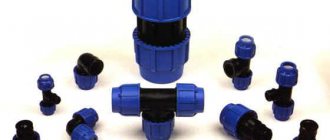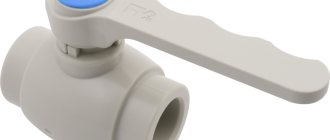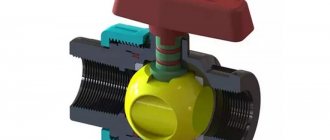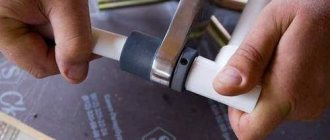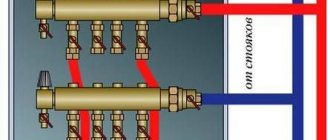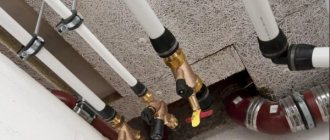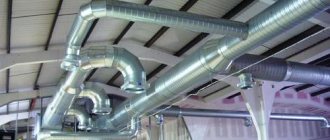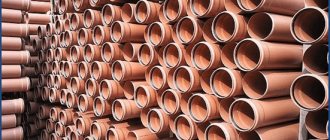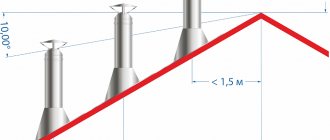Considering the responsible role, the complexity of the design and the considerable cost of the products, the installation of shut-off valves on industrial pipelines should be carried out only by high-class specialists. As practice shows, in such a process everything is important - compliance with the rules prescribed by the manufacturer, competent choice of connection location, methods of adjusting products.
Not only the return on investment, but also the safety of operating a new communication system (or a restored one, if the installation of shut-off and control valves is carried out under a repair program) depends on how responsibly the user approaches the work. What should be taken into account here?
Repair of fittings
There are three types of repairs:
- routine inspection;
- Maintenance;
- major renovation.
In the first case, the elements are cleaned of contaminants and preventative lubrication is performed. It is possible to wash the plugs from sand and other deposits that impair the tightness of the joint.
Current repairs are carried out at the place where the parts are installed. The area is first disconnected from the supply of working fluid. To clean the sealing elements, the fittings are dismantled and the seal is cut off using a knife. If there are scratches on the discs, they are removed with sandpaper and rubbed with a special paste.
Major repairs are carried out when complex defects are detected. The fittings are dismantled and repaired in the factory. For repairs, grinding machines and various laps are used. Abrasive pastes are suitable for restoring the connecting surface. After processing, the lapping materials are washed off and diamond grinding is performed. Elements that cannot be repaired are replaced with new ones.
Properly selected fittings are the key to trouble-free operation of a pipeline system of any complexity and purpose.
This is especially important when organizing oil and gas pipelines, high-pressure pipelines, industrial enterprises and energy complexes
In the video you can learn about the operating features and design of such products:
Views: 786
Installation of fittings by welding
If there is a need to replace a locking mechanism installed in a welded manner, the following steps should be taken:
- Using a grinder, a section of pipe with an installed tap or valve is dismantled.
- The metal on the cut ends of the pipe is thoroughly cleaned with sandpaper.
- Welding work is being carried out to attach a new locking device.
Welding work must be carried out by a qualified specialist authorized to carry out this type of work, with mandatory observance of safety regulations. The welder is provided with personal protective equipment.
Technical requirements
Control valves must meet a number of requirements:
- Strength indicator. It determines the durability of the product. The part must not have visible damage, irregularities, or cracks. Connections must be tight.
- Resistant to high temperatures and acids. This requirement applies to different types of pipelines. If a chemical substance flows through the line, chemical-resistant parts are used in its manufacture.
- Accuracy of shut-off valve position control. The exact values are indicated on the packaging. Deviations from the manufacturer's specifications are considered defective.
- Lifetime. Products have a period during which they will work without breakdowns. For this period, the manufacturer issues a warranty card.
- Internal and external tightness.
Products need to be periodically changed and repaired. Because of this, installation should be convenient and not cause serious difficulties.
Valve purpose
A valve is a device in which, using a spindle with a valve at the end, the valve closes or opens.
Valves are classified according to the following criteria:
- purpose (shut-off and shut-off-regulating);
- designs (pass-through, corner, direct-flow and mixing);
- case material (titanium, bronze, steel, brass, plastic);
- closure method (stuffing box and bellows).
Design advantages:
- the occurrence of friction forces between the valve and seals is eliminated;
- ease of execution;
- high level of tightness;
- Compared to gate valves, it has a short overall length.
The main diameter of the pipeline on which the valve can be found is up to 200 mm. On large diameters it is practically not used. The connection method to the water supply system is flange or coupling.
A valve is a device in which, using a spindle with a valve at the end, the valve closes or opens.
Installation of shut-off valves on the water supply system
The installation of shut-off valves on the water supply system must be organized in such a way as to ensure quick replacement or repair of the device that blocks the flow of liquid. That is, the pipe-fitting connection must be dismountable.
And this type of installation can only be provided by two technologies:
- Assembling the unit onto a threaded pair, pressed with a lock nut
- Assembling the unit onto a flange connection secured with bolts
Moreover, the specific type of connection depends on the type of pipeline. Thus, in low- and medium-pressure water pipelines (from one to 100 atmospheres), installation on a threaded pair of squeegee-housing is practiced. And in high-pressure water supply systems (more than 100 atmospheres) only flange connections are used. And further in the text we will consider both options in more detail.
Threaded installation
Threaded installation of fittings on a pipeline involves the following procedure:
- Lock nuts are screwed onto the threaded bends of the previous and subsequent pipes
- Next, the two pipes, simultaneously or sequentially, are screwed into the body of the shut-off device. Moreover, the installation site must be sealed either with a special tape or with an organic sealant - tow.
- After the pipes are screwed into the housing, another layer of sealant is screwed onto the section of the drive between the lock nut and the end of the housing.
- After installing the additional layer, it is pressed against the body with a lock nut.
The result is a fairly strong and hermetically sealed connection that can withstand pressure of up to 100 atmospheres.
Flange mounting
Flange installation is only possible if special rings are installed at the ends of the pipe and body. Moreover, these rings are placed in the valve body at the design stage of the device, and the flange ring is mounted on the end of the pipe by arc welding.
After installing the flanges, installation of the fittings on the pipeline is carried out as follows:
- A sealing gasket is placed between the flange of the pipe and the fittings. After which the flanges are tightened with mounting bolts.
- A similar operation is repeated on the other side.
As you can see, flange installation is a very simple operation that guarantees not only a tight, but also a high-strength connection between the pipe and the valve body. Therefore, this type of installation is practiced in pipelines operating under high pressure.
Installation
Shut-off valves are installed in certain places. For private houses, it must be mounted on a bypass that switches the circuit to the circulation pump or returns it to natural movement.
In other cases, such mechanisms are installed at the point where the pipeline enters the house, at the exit from the elevator unit, necessarily on each riser, on some types of heating devices and jumpers in front of them.
As for the heating circuit, shut-off valves are installed at its highest points.
Types of pipeline fittings
Reinforcement products are classified according to method of application, purpose, design. The types of fittings on pipelines are as follows:
- flanged;
- connecting;
- for pipes made of different materials;
- for nuclear power plants.
Let's take a closer look at these types.
Flanged
A flange is a flat disk with a certain number of mounting holes. The flanges of adjacent elements fit tightly to each other. The connection is made by tightening the fastening bolts with nuts. Gaskets ensure tightness. Flange fittings are installed in systems operating at different pressures and temperatures. The flange is welded to the pipe.
The flange connection is dismountable, which simplifies repair work, inspection and replacement of elements. It is made of cast iron or steel, is used for pipelines from 50 mm in diameter, can withstand temperatures up to 400 C, and can be placed in horizontal and vertical positions.
Connective
Pipeline connecting fittings are used when connecting elements made of different materials and diameters. At the point of joining of pipes made of steel and plastic, where the diameters of the elements being connected are different, connecting fittings are used.
Couplings, plugs and other fittings are installed as additional parts, the design of which does not have a locking and adjusting mechanism. Such elements ensure quick installation and replacement of pipeline parts. Connecting elements are produced with a cross section of 25-2020 mm, for pressure from 1 to 4 MPa, from cast iron, steel, and plastic.
Stainless
Stainless steel pipe fittings form a connection that does not react chemically with the working environment, which ensures the longevity of the system. Elements such as valves, taps, adapters, gate valves are used for stainless pipelines when transporting food liquids, alcoholic and non-alcoholic drinks.
Stainless steel elements form a strong connection that is resistant to corrosion and aggressive environments, which ensures its use in the petrochemical and gas industries, pharmacology, and nuclear power plants. The parts do not interact with the transported products and do not change its structure.
Valves for nuclear power plants
A nuclear power plant is a high-risk energy facility. Its design includes a large number of pipelines, and industrial pipeline fittings are installed. The following requirements apply to the elements:
- The direction of movement of the working fluid must coincide with the arrow on the body.
- Do not use parts that are not suitable for their intended purpose.
- Access to all types of fittings must be free.
- Cover the connecting elements of the pipeline that are heated during operation with a removable structure with thermal insulation, secured with threads.
Separate parts of a pipeline under high or medium pressure are connected by welding or flange fittings, which reduces the possibility of leaks. The material for the products must be high-quality metals.
Important: to ensure the safe operation of steam generators, safety valves are installed - main and auxiliary. To remove drainage from the station circuit, first install a shut-off valve, then an adjustment valve.
Metal-plastic pipe fittings
Metal-plastic pipes are used for installation indoors. This is internal plumbing and heating. The sections are connected by valves, shut-off and transition valves and other elements. They are used at coolant temperatures up to 95 C and pressure 16 atm.
Pipelines made of metal-plastic are used in everyday life, have a neat appearance, and have a threaded or pressed connection. The fittings are made of nickel-plated brass. The products have standard sizes and are marked on their surfaces.
Fittings for polyethylene and polypropylene pipes
Fittings for plastic pipes are distinguished for pressure and non-pressure systems. For polyethylene pipes, a welded connection is considered the most reliable. As a result, we get a single cast sealed pipe.
American: what is it, a fitting for connecting pipes A device used to combine individual elements of pipelines into a single circuit, consisting of a union nut and threaded bushings, is called an American fitting among plumbers. Used in…
To regulate the flow and divide it into separate parts, taps, dampers and valves are used that can withstand pressures of up to 16 atm and temperatures from 45 to 80 C. Brass, bronze, and steel fittings are used. For water supply, it is permissible to install polyethylene taps with a metal insert.
Butterfly valve
This is where the flange connection is made. In this case, the flanges must be parallel to each other. Before installation, make sure that there are no chips, holes, burrs or other damage on the surface of the flanges that could impair the tightness. Before starting installation, the rotary disk must be opened slightly, but not completely.
It should not extend beyond the butterfly valve body. Then, using studs or bolts, you can lightly grab it. Next, the butterfly valve disk opens completely, after which the fasteners are evenly tightened. If the installation process was completed correctly, the shutter should open and close with ease.
Instrumentation and automation devices in gas pipeline systems
In addition to all of the above, numerous instrumentation and automation devices (instruments and automation) are used in gas pipeline systems.
In addition to gas fittings, instrumentation and control systems are installed on gas pipelines. This allows for constant monitoring of the condition of the equipment and the progress of the technological process. And also quickly identify pre-emergency and emergency situations
The most popular devices used in gas systems are:
- gas alarms;
- equipment for emergency shutdown of incoming gas;
- equipment for measuring the volume of gas passed through;
- electronic regulators of the gas volume passed;
- autonomous power supplies;
- gas valves for automating various processes and optimizing the operation of pipelines;
- gas regulators for regulating the volume of medium passing through some section of the pipeline.
Such devices are high-tech equipment used in a wide variety of conditions.
Types and models
To decide which taps to install on heating radiators, you need to become more familiar with their varieties, as well as find out their main characteristics.
Regulating – controls water flow manually, comes in two types: straight and angular.
Pros:
- allows you to work on a specific radiator without shutting down the system;
- gently fills the system;
- has excellent tightness;
- has positive hydrodynamic qualities;
- characterized by a stylish aesthetic appearance.
Minuses:
- inability to accurately adjust heat transfer, which is caused by the technical features of the device that do not provide for the presence of a scale for determining the temperature regime;
- preference for installation in autonomous heating systems.
Their functionality is provided by a sensitive element that responds to thermal changes by increasing or decreasing the flow intensity in the system.
At the same time, there are thermal heads with manual or automatic adjustment types, which are mounted on one- and two-pipe systems.
Pros:
- independent adjustment of the required temperature indicator;
- reasonable fuel economy, which is achieved by limited temperature;
- availability of a mode that protects the system from freezing.
Minuses:
In the case of single-pipe systems, a bypass is required.
Let's look at taps for heating radiators: which ones are best used for these purposes.
- spherical models, the main feature of which is the presence of two modes - open and closed, activated by changing the position of the valve in the form of a ball;
- cone valves with an additional intermediate position;
- air vents, presented on the market by the Mayevsky crane model and representing a fairly simple design with a thread for installation in the radiator plug;
- automatic regulators, characterized by reliability and ease of use.
Famous brands
When you go shopping for a radiator tap, we recommend that you familiarize yourself with the advantages of the offers from the most popular manufacturers on the market.
Itap products are characterized by anti-corrosion resistance, durability and manufacturability. The cost is 400-1200 rubles.
Oventrop products are represented by nickel-plated cases of a reliable collapsible design, increased connection density due to external threads, and an affordable price - 350-750 rubles.
Luxor shut-off valves are quite versatile, which is achieved thanks to a body made of brass with nickel plating, heavy-duty and economical, moreover, with an affordable price of 360-450 rubles.
In any case, the main criterion should remain the high quality of the material and technology for the production of cranes.
How to connect a radiator? Required fittings
The first thing, perhaps, that we should decide upon when connecting a radiator is whether we want to regulate its heat transfer or not?
If so, how: automatically or manually? When we simply need to be able to disconnect the radiator from the heating network, the type of fittings we need will be limited to two ball valves on the supply and discharge pipelines.
There are two options with the ability to regulate heat transfer: manual and automatic.
Manual fittings are more cost effective and require adjustment every time the radiator temperature needs to be changed. However, it is less sensitive to the quality of the coolant, which is critical in apartment buildings. On the other hand, automatic adjustment allows you to make a one-time setting to a comfortable temperature value, after which this type of fitting will maintain the set value independently. Such fittings are more expensive and more sensitive to dirt and rust in the heating network, i.e. more suitable for private homes or for heating systems where the maintenance service closely monitors the cleanliness of the coolant.
Manual adjustment is all kinds of options for radiator control valves that are installed at the inlet of the radiator. For example:
| VT.007.LN | VT.008.N |
Automatic adjustment is a thermostatic radiator valve, which is also installed at the inlet of the radiator plus a thermostatic head (automatic, mechanical regulator). It should be noted that both the thermostatic valve and the thermal head will not perform the function of regulating the coolant flow through the radiator without each other. This is what they look like:
| Valve VT.031.N | Valve VT.032.NR |
| Thermal head VT.5000 | Thermal head VT.1000 |
After we have decided which type of adjustment suits us best, before purchasing fittings we need to find out what type of heating system is in our house: single-pipe, double-pipe or radiant.
In a one-pipe heating system, the coolant inlet and outlet are connected to one pipe. For example, it looks like this:
(Important! In the case when next to the pipe connected to the radiator there is another pipe that is not connected to the radiator, such a system remains single-pipe).
In a two-pipe heating system, the coolant inlet and outlet lead to different pipes:
In a radial system, each radiator is supplied with coolant separately from the collector, which, as a rule, is located on the same floor of the building as the radiator itself. Typically, in such heating systems, the coolant flow control is located on the collector itself, and the pipelines to the radiator are routed in the floor or in decorative boxes. To connect the radiator, in this case, ball valves at the supply and return outlets are sufficient.
Why do you need to know the type of heating system? The fact is that for single-pipe heating systems, the fittings must have low hydraulic resistance (i.e., high throughput). For two-pipe and beam systems, throughput is less critical. For this reason, valve manufacturers often make different valve options for different systems. Installing “two-pipe” valves in a one-pipe heating system can lead to the fact that the coolant simply will not flow into the radiator or will flow in insufficient quantities, which will manifest itself in the heating of only part of the radiator.
In addition to the control valves, there is also a tuning or, as it is also called, balancing valves. We do not consider it within the framework of this article for the simple reason that the need and configuration of this fittings is determined at the design stage of the heating system. The user will not be able to independently determine the need for balancing valves and adjust them. The idea is this: if when you bought an apartment you had balancing valves at the outlet of the radiator that look like this:
then you will need them, if not, then there is no point in installing them.
Pipe design
The design features of the device allow us to distinguish several main groups of connecting pipes:
- the coupling version of the connection is suitable for small and medium diameters, and has an internal thread type at the connecting ends, intended for joining by screwing;
- The flange connection option is distinguished by the presence of disks or squares with special holes for bolted connections to pipelines;
- pin-type connection with a quick-release connection and the presence of a special sealing gasket, is a pair or more screw grips;
The fitting version of the connection involves joining (the rules for installing metal-plastic pipes are written in this article) using an external thread and a union nut using a sealing gasket.
In special cases, when there are significant diameters of the areas being connected or there is a need to obtain the most reliable joining, welding is used.
Tips for choosing
The choice of fittings depends on several factors, including:
- indicators of working pressure and temperature of the medium in the pipe;
- location on the pipeline;
- frequency of actuation or switching cycles;
- the cross-sectional size of the nominal diameter of the connection pipes and the type of connection;
- material of body parts and presence of anti-corrosion coating;
- permissible level of hydraulic resistance;
- having a throughput capacity of the appropriate volume;
- geometric parameters of the product.
In systems with more powerful and severe loads, cast iron fittings are installed.
Plastic products are considered the least reliable, but in some cases their use is allowed.
As with the purchase of any other product, many people choose the most inexpensive products. But you should not focus only on their cost, since a truly high-quality and reliable device will not be too cheap.
It is also advisable to choose models from trusted manufacturers and in specialized stores that can provide guarantees of the quality and reliability of their products. After all, the functioning of the system and its durability depend on the correct choice of shut-off valves for the water supply system.
Varieties
Pipeline fittings are classified depending on various factors. By purpose:
- Safety. Protect lines from sudden pressure changes. Thanks to automation, excess pressure is released.
- Locking. Designed to block the flow of liquid or gas. They work in two positions - closed, open.
- Connecting. Most often it has union nuts that simplify the connection process.
- Regulatory mechanisms. The design is similar to locking parts, but can regulate the intensity of liquid and gas supply.
- Distribution. Designed to connect additional circuits to a common main line and create separate branches.
Types of pipeline fittings depending on the design:
- Valves - suitable for installation on circuits with low pressure of the working medium. They only work in the closed/open position. To change the position you need to use a special valve that needs to be turned.
- Valves - shut-off and control valves. Allows you to completely shut off the flow of liquid or regulate it. The position is changed manually by turning the handle.
- Valves are parts that shut off flow when pressure increases. They can be installed in places where it is necessary to change the direction of fluid flow.
- Cranes are structures that are suitable for adjusting, shutting off, and changing the direction of flow of the working medium. Used for assembling liquid and gas supply lines.
A separate group of shut-off valves is gate valves. Installed on industrial highways. They are classified depending on the design, principle of operation of flanges and valves.
Depending on the sealing method, three more types of structures are distinguished:
- Gland fittings. There is a stuffing box inside. Thanks to it, the spindle is compacted.
- Bellows parts. A bellows is used for sealing.
- Membrane fittings.
Connecting parts are classified according to the control method. They can be manual or automatic.
Shut-off valves (Photo: Instagram / sanremo67)
Check valve
Check valve for water supply
Installation of a check valve is necessary in cases where a pumping station is used.
Its installation is carried out immediately after the station or after the ratchet on the suction pipe. To install a check valve, you must use a special drive. In this case, the squeegee must be installed on both sides of the check valve.
Moreover, during installation it is important to follow the arrow, which should go in the same direction as the water flow. The valve diameter must completely match the diameter of the pipes. It is not recommended to use adapters from a smaller to a larger diameter, and vice versa.
Preparation of pipes, valves, fittings
The first step is to study the instructions for the soldering machine. It contains all the recommendations, as well as restrictions on the use of the machine. The instructions also contain a table from which you can determine the heating time of the pipeline elements.
Next, the workplace is prepared, as mentioned above. You need to secure the welding machine with a clamp and connect it to the network. Set the operating mode to 260 oC. The temperature is set on a special regulator.
Now you need to clean the Teflon inserts and put them on the machine. All that remains is to wait for the welding to warm up. The soldering iron must not be turned off during the entire operation. The set temperature regime will prevent overheating of the Teflon inserts. But under no circumstances should you lower the temperature. The resulting connection will be unreliable, will wear out over time and leak.
Now you can move on to preparing the pipes. First you need to make pieces of suitable sizes. All cuts should be carefully processed. The reinforcing layer is removed. Using a scissor cutter, the edge of the pipe is cut off; now you need to chamfer it with a cone-shaped cutter. The surfaces to be soldered should be degreased, cleaned of dirt, dust and uneven surfaces should be removed.
What types of pipeline fittings are there: types and purpose
Depending on the type, pipeline fittings perform various functions:
Constipated.
One of the most popular. It serves to completely block the flow of the working medium, therefore the main quality and basic indicator is tightness and its service life. The position in which this valve can be located is “open” or “closed”; there is no intermediate position.
These types of pipeline fittings are used in aviation, maritime transport, in devices that are used at great depths, space technology, nuclear energy and, of course, in gas and oil pipelines.
Today, pipelines are quite complex structures, so the slightest disruption in operation can cause a failure in the entire process, which can lead to dire financial and environmental consequences.
An interesting fact is that the combination of words “shut-off valve” is not used in speech, just as the words “shut-off”, “shut-off” with the name of some type of valve are not used. And this applies not only to valves.
Reverse.
It is not recommended to call it a reverse-acting valve. Such a system is designed to prevent the backflow of the working fluid using automatic action.
Safety.
Thanks to the automatic release of excess working fluid, the purpose of safety valves is that they protect equipment from excess pressure or other parameters that could lead to an accident. You can find safety valves on a steam boiler as a safety valve
Its importance is very great - it ensures the stable operation of the pipeline, as well as industrial and energy installations. Safety valves help to avoid, prevent and negate the result of exceeding the possible parameters of the working environment, which arise due to equipment malfunction, as a result of personnel errors, due to physical processes that occur inside the equipment itself or external influences.
Distribution and mixing.
Distribution and mixing fittings are suitable for distributing flow in various directions; in this case, the pipeline system will be called distribution. In the case where the fittings are intended only for mixing the flow of the working medium, the name of this unit will be “mixing fittings”. When the fittings perform both functions at once, it is called distribution and mixing.
Regulatory.
A significant role in the pipeline is played by control valves, the purpose of which is the ability to regulate the parameters of the working environment. This leads to the safety of technological processes and forms quite complex production chains that can consist of many components. The advantages of control valves are to ensure normal conditions for the operation and good controllability of equipment. Due to its characteristics, this valve can be used at such critical facilities as nuclear power plants. It can be used independently or in combination with a shut-off valve.
Disabling.
In some sources, shut-off valves are called protective valves. At sensitive objects, a pressure drop is possible, therefore, in order to completely block the flow rate of the working medium, this shut-off (protective) valve is used. The advantage of this valve is that it is capable of shutting off a specific element, unlike safety valves, where the flow of the working medium is vented.
There is a combined pipeline fittings. It includes the functions of those types of fittings that were listed above. By the name you can easily understand what purpose they serve. Examples of types of pipeline fittings include: shut-off and control valves (no need to call them shut-off and throttle valves) or shut-off and check valves.
Non-return-controlled and non-return-shut-off valves are also used as check valves. The functions they perform are: forced complete closure of the stroke of the locking element (non-return shut-off valves) or, in addition to closing, also limiting the stroke (non-return control valves).
Read material on the topic: Angle valves for radiators
Shut-off and control devices for heating systems
Shut-off and control valves for heating are manufactured specifically for operation at elevated temperatures. Made from materials that allow you to work in high temperature conditions. Most often, such pipes include bronze or stainless steel. Depending on the heating systems, different devices can be installed.
Shut-off valves for heating are used for different purposes:
- Branches on pipes. Allows you to shut off the line or redirect the flow of working fluid if necessary.
- Mayevsky crane. Ball valve. Designed to remove excess air and reduce pressure in the system.
- Check valves. They provide the opportunity to direct the flow in the right direction to reduce the likelihood of breakthroughs.
- Faucets. Mix hot and cold streams.
What plumbing fittings are needed for polypropylene pipes?
coupling
The coupling comes with or without threads, the installation of which is carried out using glue or welding. If the pipeline is collapsible, then it makes sense to use a threaded coupling
The coupling can be used in polymer and steel pipelines, but it is important that its material and the material of the pipes are the same. Often in the store you can purchase couplings specially made for this plumbing equipment, which is convenient for ordinary buyers
The use of a coupling ensures reliable and long-term operation of plumbing fixtures without leaks.
Read the material on the topic: Water leakage protection systems - a safety feature for your home
Crosses and tees
This type of plumbing fittings allows you to create the desired pipeline design; with their help, it becomes possible to distribute flows of various media in the desired directions; most often they are now used for the installation of polypropylene pipes. Crosses and tees are made from high-quality, high-strength materials, which makes them resistant to many types of aggressive environmental influences; they are routinely used in the installation of heating systems of various types of buildings and structures, the pipes of which are made of polypropylene.
The advantages of using crosses and tees include:
- High tightness, which is achieved only with proper installation performed by qualified workers;
- The service life is 25-30 years, which directly depends on the working environment used; if the environment is aggressive, then this period is reduced;
- Lightness, which means convenience and simplicity of installation and dismantling in different, including difficult, conditions;
- Ensuring uninterrupted operation of the equipment throughout its entire service life, subject to the high quality of the plumbing fixtures themselves;
- If necessary, they allow the pipes to be rotated in the desired direction to move the flow of the working medium in the desired direction in accordance with the characteristics of building structures.
Crosses are used to connect pipes that, as a rule, have the same diameter. With their help, pipes are connected at right angles, using them, you can create complex layouts of communication networks with a transition from vertical to horizontal pipe layouts and vice versa
With the help of a cross, moving working media are both branched in different directions and different flows are combined into one, and it does not matter what their temperature is - high or low. Crosses are used for plumbing equipment of various types of buildings, structures, residential and non-residential premises; they are applicable in various industries, including chemical and food industries
This is achieved thanks to the reliability and functionality of this type of plumbing fixtures, however, it is important that the material from which it is made cannot be destroyed under the influence of the environment used, including aggressive ones, in water pipes and other plumbing fixtures.
If we talk about modern and lightweight polypropylene pipes, then the crosspieces for them are made from static white or gray high-pressure propylene by injection pressing. They can be used at temperatures up to 1000 degrees Celsius. Such plumbing fittings, depending on the pipe connector, can be either equal-bore or multi-bore. Installation of the polypropylene cross is carried out by butt welding using a special welding machine.
Read material on the topic: How to choose components for pipes
Bends
A bend is a small section of pipe, which is given a special curved shape; it is welded into its section in a place where it is impossible to install a regular straight pipe. The outlet has a specially adjusted shape, which allows the pipeline to be installed even in difficult places of non-standard shape.
Ball valve
This type of fittings is used in modern polypropylene pipes for high or low temperature water in various rooms and buildings, both industrial and domestic.
The ball valve can be easily installed in almost any conditions, it is convenient and reliable in operation, and can be used in both reinforced and non-reinforced modern polypropylene pipes. This type of plumbing fixtures has good throughput (throughput is the amount of working fluid that passes through a section in a certain period of time), which prevents the deposition of dangerous salts and other solid impurities in it. Date: September 25, 2021
Areas of use of polyethylene pipes
- Transportation of household and drinking water through pipelines; In gas supply systems, including for flammable gases; Pipelines for sewerage and water disposal; In drainage systems and for wastewater disposal; For water filling and drainage in swimming pools; For soil moistening in reclamation systems; As protective case when laying fiber optic or electrical cables.
Almost all modern water supply networks, gas pipelines, sewer and drainage systems are installed from lightweight, corrosion-resistant polyethylene pipes. Their advantages are obvious.
